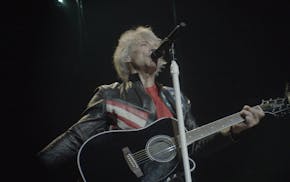Many years ago, when my sister died, friends gave me a copy of Terry Tempest Williams' book "Refuge," which is about the death of her mother, the damage we do to the natural world, the acceptance of change and the importance of nature. It is one of more than a dozen books Williams has written, all of which share themes of the natural world.
Williams will be at Magers & Quinn in Minneapolis this week to discuss "The Hour of Land," her new book about our national parks, and I was fortunate enough to chat with her in late June. She was in China at the time, so our conversation took place by e-mail and her answers here are slightly edited for length.
Q: What are you doing in China? And where are you right now?
A: We are on a train traveling back to Beijing from Luoyang, where we visited the Longmen Caves with immense Buddhas carved out of stone on a hillside along the banks of the Li River. Many of the Buddhas were destroyed during the Cultural Revolution and yet, faceless and broken, still the Buddhas sit.
Outside my window, I see farmers wearing Chinese straw hats bent over in the fields, many electrical towers and very poor air quality. We are in China as guests of several Chinese universities in Shanghai and Beijing to lecture and conduct workshops on ecocriticism and environmental writing.
Q: How did you choose the parks you wrote about in "The Hour of Land"?
A: I selected those I knew well (Grand Teton, Canyonlands); those I dreamed of seeing for the first time (Big Bend, Gates of the Arctic); those with difficult histories (Gettysburg, Alcatraz); and those I had never heard of like Effigy Mounds National Monument in Iowa. I imagined them as guests at a dinner party in conversation with one another: Cesar Chavez National Monument speaking to Glacier National Park where the Blackfoot Nation would have something to say to the United Farm Workers.
Q: You are known for unusual structures with your books. How did you decide on the structure for this one, which is not straight narrative but includes poetry, stories and letters?
A: The structure was inspired by Jorie Graham's poem entitled "WE," first published in the London Review of Books. Each chapter, each national park, is in response to a line from that poem.
Q: One of the parks you write about is Theodore Roosevelt National Park. You write about the damage that fracking and the oil rush have done, but then you quote your father, who has a different view. Why did you include his voice?
A: I included my father because he has always included me in his shared love of the land. Although our politics could not be more different, our love of wild nature binds us together.
My father, John Tempest, has laid pipe in eight western states. He would tell you he is "proud of the scars he has left on the western landscape" so people can heat their homes and have water to drink from their taps. He had never been to Theodore Roosevelt National Park. He was curious about the Bakken oil boom nearby. We visited both. The juxtaposition between the two landscapes in North Dakota — one wild, protected, and the other a boom town that was leaving the land and its workers shattered — touched him deeply. His point of view deserves to be heard if we are to understand the soul of America at this moment in time.
Q: Talk to me about the connections between grief, healing and the land.
A: We are earth.
We are fire.
We are water.
We are air.
Our relationship to this beautiful blue planet is fundamental. Finding beauty in a broken world is creating beauty in the world we find. Body. Earth. No separation.
When I read your question about grief, healing and the land — the word that comes to mind is perspective. Standing on the edge of the Grand Canyon, whatever grief we are carrying, whatever stress we are holding, whatever is plaguing humanity is absorbed into this magnificent eroding chasm shaped by wind, water and time.
My perspective returns.
My breath deepens.
And I can feel the larger circles and cycles of life and my heart is calmed.
There is a profound patience in stones, a willingness to not only endure change but to trust it — we hold a small testament to geologic time in the palm of one's hand.
Humbled as a human. Perspective.
This morning my friend Li Hua said this: To be brave with weapons is easy. But to be brave when an injustice is done to you or when sorrow fills your heart and you do not choose the path of anger but remain calm — this is true bravery.
The natural world makes us brave. Our hearts remain tender and we can keep our eyes steady, wide open.
Grief dares us to love once more.
The land absorbs our pain. Hands on the Earth, we remember where the source of our power lies.
This is where my joy and my healing are rooted —
I can choose to not avert my gaze.
And for a moment, my soul is still.
Terry Tempest Williams will discuss "The Hour of Land" at 7 p.m. July 6 at Magers & Quinn, 3038 Hennepin Av. S., Mpls.
Laurie Hertzel is the Star Tribune senior editor for books. On Twitter: @StribBooks. On Facebook: facebook.com/startribunebooks

The Biden administration is tweaking rules on airline fees and refunds, saying it'll help consumers

3 hearty salads to kick off salad season
Ask Amy: Late mom's behavior still an issue

TV review: Bon Jovi documentary goes down in a blaze of boredom

